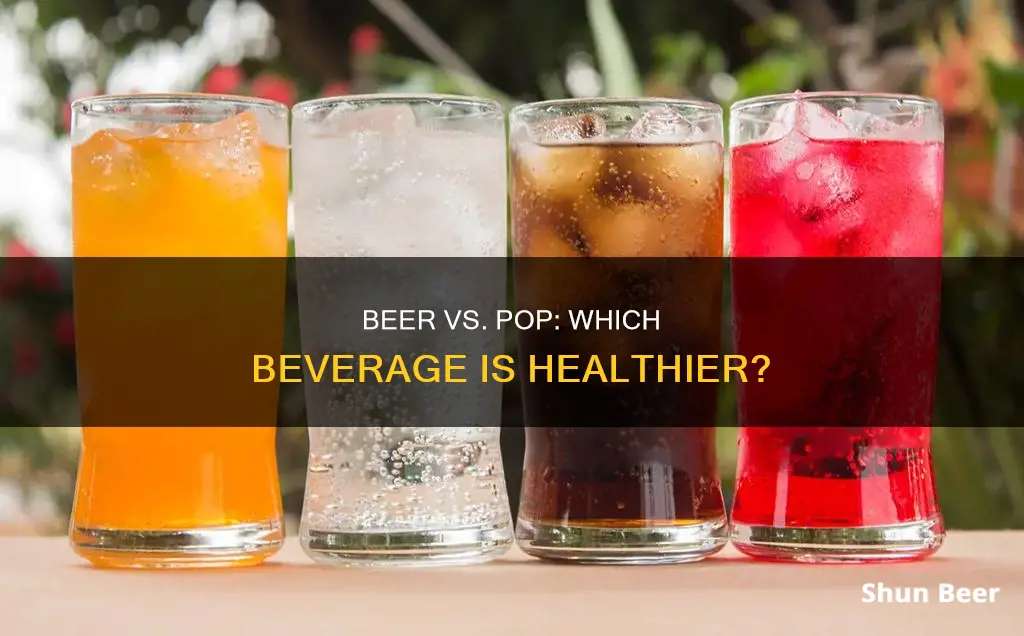
Beer and soda are both unhealthy, but which is worse for you? Beer contains very little sugar, whereas a standard can of soda contains around 39 grams—far exceeding recommended daily sugar intake. However, beer contains more calories than soda, and the presence of alcohol in beer can affect your judgment and coordination. Soda, on the other hand, is highly acidic and can damage your teeth and bones, and both drinks can cause weight gain and increase the risk of diabetes and heart disease.
What You'll Learn

Sugar Content
While beer and pop are both unhealthy, beer has a lower sugar content.
A 12-ounce can of standard soda contains about 39 grams of sugar, which is equal to about 9 teaspoons. This is well above the recommended daily intake of sugar for both men and women, according to the American Heart Association (AHA). Regularly consuming high levels of added sugar increases the risk of higher blood pressure, inflammation, weight gain, diabetes, and fatty liver disease.
On the other hand, beer contains very little sugar. A standard 12-ounce serving of regular beer contains around 1 to 2 grams of sugar, which is significantly less than soda. The sugar in beer comes from the natural sugars found in the grains used during the brewing process. During fermentation, yeast consumes much of the sugar to produce alcohol, resulting in a relatively low final sugar content. Light beers typically have slightly less sugar, while craft beers or specialty beers with added ingredients may have slightly more.
When it comes to sugar content, beer is the healthier option compared to pop. However, it is important to note that both beverages should be consumed in moderation as part of a balanced diet.
Hard Seltzer vs Beer: Which is the Healthier Choice?
You may want to see also

Calories
When it comes to calories, neither beer nor soda is a healthy choice. While beer is often associated with \"beer bellies\", soda is sometimes called a \"liquid candy\". Both drinks are high in calories and offer little to no nutritional value.
A 12-ounce can of beer typically contains 100 to 150 calories, depending on the type and alcohol content. Light beers have the lowest calorie count, ranging from 90 to 100 calories, while regular beers usually contain 140 to 180 calories. Craft beers can vary significantly, ranging from 150 to 250 calories, and high-alcohol beers, such as IPAs or stouts, can have 200 to 350 calories or more. The alcohol content is the primary factor influencing the calorie count in beer, with carbs playing a secondary role.
On the other hand, a 12-ounce can of standard soda contains about 140 to 170 calories, derived mostly from sugar. Diet sodas, on the other hand, often have zero or minimal calories due to the use of artificial sweeteners. However, the extreme sweetness of diet soda may increase your appetite for sugary products and lead to other poor dietary choices throughout the day.
While beer generally has fewer calories than soda, it is important to note that both drinks are high in calories and offer little to no nutritional value. Therefore, if you are concerned about calorie intake, neither beer nor soda is a healthy choice.
In terms of overall health, beer may offer some advantages over soda. Beer has no fat, no sugar, and fewer calories and carbs than soda. Additionally, beer provides some minerals and vitamins, including thiamin, riboflavin, niacin, vitamin B-6, follate, and vitamin B-12, while soda has no vitamins or minerals. Beer also has a lower glycemic load than soda, which can aid in weight loss, maintaining consistent blood sugar levels, reducing the risk of circulation disease, and lowering the risk of diabetes.
Hoppy Beers: Healthy or Hype?
You may want to see also

Ingredients
When it comes to ingredients, neither beer nor pop can claim to be a "healthy" beverage. However, beer has a slight edge over pop in this regard.
Beer Ingredients
Beer is traditionally made from four primary ingredients: water, malt/grains, hops, and yeast.
- Water is the main component of beer, comprising around 90% of its content. The quality and mineral composition of the water can affect the taste and character of the final product.
- Malt refers to germinated and dried cereal grains, predominantly barley. The malting process converts the starches in the grains into fermentable sugars, which are essential for the brewing process.
- Hops are the flowers of the hop plant (Humulus lupulus). They contribute bitterness, flavour, and aroma to the beer, and also act as a natural preservative, extending its shelf life.
- Yeast is a microorganism that ferments the sugars in the malt, producing alcohol and carbon dioxide.
Pop Ingredients
Traditional pop, on the other hand, is typically made with a range of questionable and controversial ingredients that offer little to no nutritional value. These ingredients include:
- High-fructose corn syrup or cane sugar, which provide a high level of sweetness.
- Carbonated water, which gives pop its fizziness.
- Caramel colour, which gives pop its familiar dark colouring.
- Citric acid and phosphoric acid, which add tanginess and tartness while also preserving the drink.
- Sodium benzoate, a chemical preservative that extends the shelf life of the pop.
Healthier Option
While neither beverage can be considered truly healthy, beer does contain some trace minerals, such as potassium, magnesium, phosphorus, and selenium. Additionally, the ingredients in beer are generally less processed and more natural than those in pop.
Beer's Health Benefits: Friend or Foe?
You may want to see also

Satisfaction and Satiety
When it comes to satisfaction and satiety, both beer and soda can increase your hunger drive and reduce your resistance to unhealthy foods. However, beer is more likely to make you feel full or bloated than soda. This is due to the carbonation in beer, which can create a bloating sensation, as well as its higher calorie and carbohydrate content. On the other hand, soda suppresses the feeling of fullness you would typically experience after a meal, leaving you feeling hungrier.
Beer drinkers may feel more satisfied after drinking a beer due to the carbonation, calorie content, and the presence of alcohol, which can increase appetite. However, alcohol can also impair judgment and coordination, leading to poor food choices. Additionally, the high sugar content in soda can also impair judgment and lead to increased food consumption.
While beer may provide a greater sense of satisfaction and satiety compared to soda, it is important to note that both beverages can negatively impact your appetite and food choices. Therefore, it is crucial to consume them in moderation as part of a well-balanced diet and exercise routine.
Truly's vs Beer: Which is the Healthier Drinking Option?
You may want to see also

Acidity
When it comes to acidity, neither beer nor soda can be considered healthy beverages. However, the two differ in their pH levels, with beer generally being less acidic than soda.
The pH scale ranges from 0 to 14, with 7 considered neutral. Anything below 7 is acidic, and the lower the number, the higher the acidity. Beer typically has a pH level between 4 and 4.5, which is slightly acidic. The pH of beer depends on various factors, such as the type of malt, hop varieties used, and the fermentation process. The different styles of beer and their unique fermentation processes make it challenging to determine a generic pH level for all beers. However, it is widely accepted that beer has an average pH of 4, making it slightly acidic.
Soda, on the other hand, is highly acidic. Most sodas have a pH level between 2.5 and 4, which is significantly more acidic than water, which has a pH of 7. The high acidity of soda can have several negative effects on health, including dental health issues such as tooth enamel erosion and tooth sensitivity. The acid in soda can also cause acid reflux or heartburn in some individuals. Additionally, excessive consumption of acidic beverages may negatively impact bone health over time.
While beer is also acidic, its acidity is generally milder compared to soda. The carbonation in beer, resulting from the dissolution of carbon dioxide (CO2) in water, contributes to its acidity. The pH of beer can vary depending on the style and brewing process, but it rarely falls below 4. The mild acidity of beer is usually not a significant health concern when consumed in moderation.
In summary, while both beer and soda are acidic, beer is less acidic and, therefore, considered the lower acidic beverage of the two. However, it is important to remember that neither beverage can be considered truly healthy due to their acidic nature and other potential negative health impacts.
Whisky vs Beer: Which Booze is Better for Your Health?
You may want to see also
Frequently asked questions
Beer and pop are both bad for you and can be addictive. Beer has fewer calories and less sugar than pop, but it also has alcohol, which can impair judgment and coordination and negatively impact mental health. Pop has a lot of sugar, which can lead to health issues such as diabetes and weight gain. However, beer is also often consumed with fried, unhealthy snacks, which can be just as bad for you.
Beer has some vitamins and minerals, but not enough to provide a substantial amount. It can also stimulate your appetite and reduce your inhibitions, potentially leading to overeating. Beer also has a lower acidity level than pop, which can be better for your dental and digestive health.
Pop has zero health benefits. It contains no vitamins or minerals and is highly acidic, which can lead to dental cavities and tooth sensitivity.







